Kathy Nauman Success Story
In 2014, at age sixty-four, I began to experience pain in my left hip that eventually became quite debilitating. For the first time in my life, I went to a chiropractor, which resulted in relief that lasted a couple of years. By 2015 I had consulted first one, then a second orthopedic surgeon, who recommended a hip replacement due to osteoarthritis.
The first clinic I went to, I felt like I was visiting a bone and joint factory…I decided to wait. The second place, they were reading another patient’s notes! That doesn’t give you a lot of confidence!! Not feeling completely comfortable with either of the surgeons, I began doing my own research.
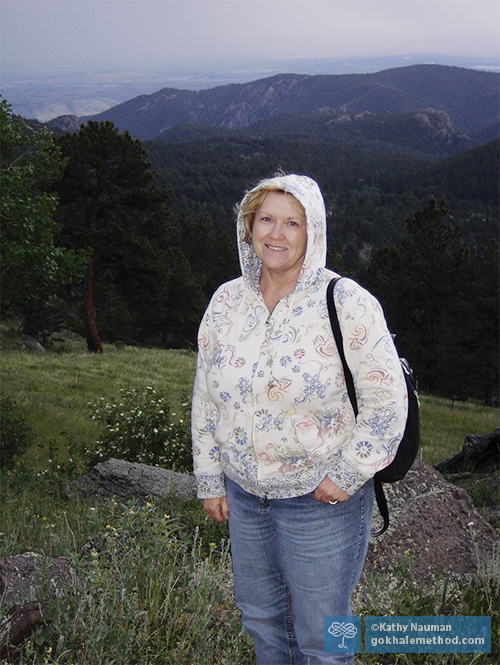
I longed to get back to hiking and walking pain-free.
I’m not one of those people who jump into things, especially surgery. So I went to a clinic where they did a lot of rehabilitative physical therapy and I asked one of the PT’s: of the people you work with who have success with their surgery, which surgeons do they use? And that’s how I found my hip surgeon. After a successful surgery in January 2016, as well as physical therapy sessions with the excellent physical therapist who recommended the surgeon to me, I recovered quickly and was thrilled to resume walking without pain.
During the summer of 2018, while out shopping, I experienced both of my knees feeling as if they were on fire. My knees continued to bother me, but, afraid an orthopedic surgeon would tell me I needed surgery, I consulted a sports medicine doctor. He performed X-rays and confirmed that I had osteoarthritis in both knees. He suggested physical therapy and braces, as well as steroid shots (which I declined). Physical therapy helped to provide some relief as the muscles around my knees strengthened.
The following year, I read an article by Christiane Northrup, M.D., in which she shared information about the Gokhale Method®. I researched the method and learned that a one-day Pop Up course, one of the in-person ways to learn the Gokhale Method, would soon be offered in a nearby town, Boulder, Colorado. After the course, I did my best to focus on glidewalking, which did reduce the bone-on-bone knee pain.

Everyday activities, such as bending, are taught in Gokhale Method group courses. Bending can be done in ways that align the bones well, use muscles appropriately, and spare the joints. Learning to hip-hinge benefits the knees, hips, shoulders and neck, and more besides.
I made it until June 2021, when I had successful bilateral knee replacements with the same surgeon. I opted to do them both at the same time to get it over with, but recovery was challenging. After weeks of physical therapy, I was told to just do normal everyday activities. However, I did not feel I was making the progress I wanted.
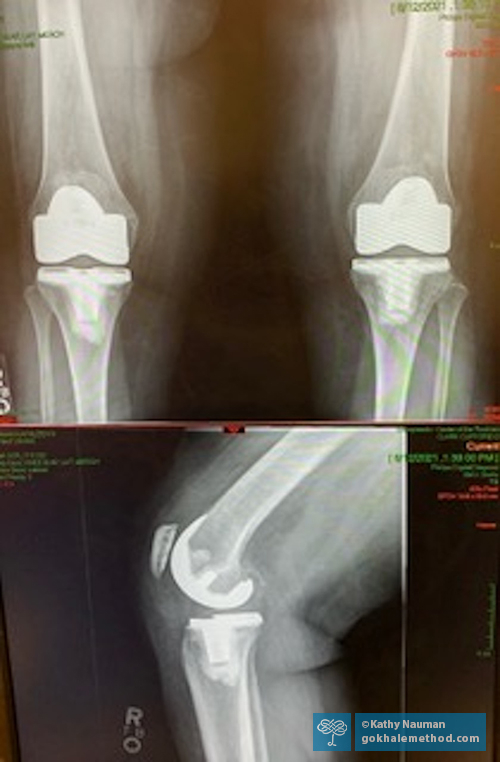
My husband took these photos of my knee replacement X-rays at my 6-week post-operative follow-up appointment. Our joints are precious things to take care of!
Because COVID was still raging, I joined the new Gokhale daily online program. This enabled me to extend my recovery in a more enjoyable and focused way, and my knees became ever stronger. Even now, if I am unable to participate in the day’s live session, just receiving the email about the topic of the day is a great reminder and encourages me to focus on practice. And I regularly watch the replays if I miss a session.
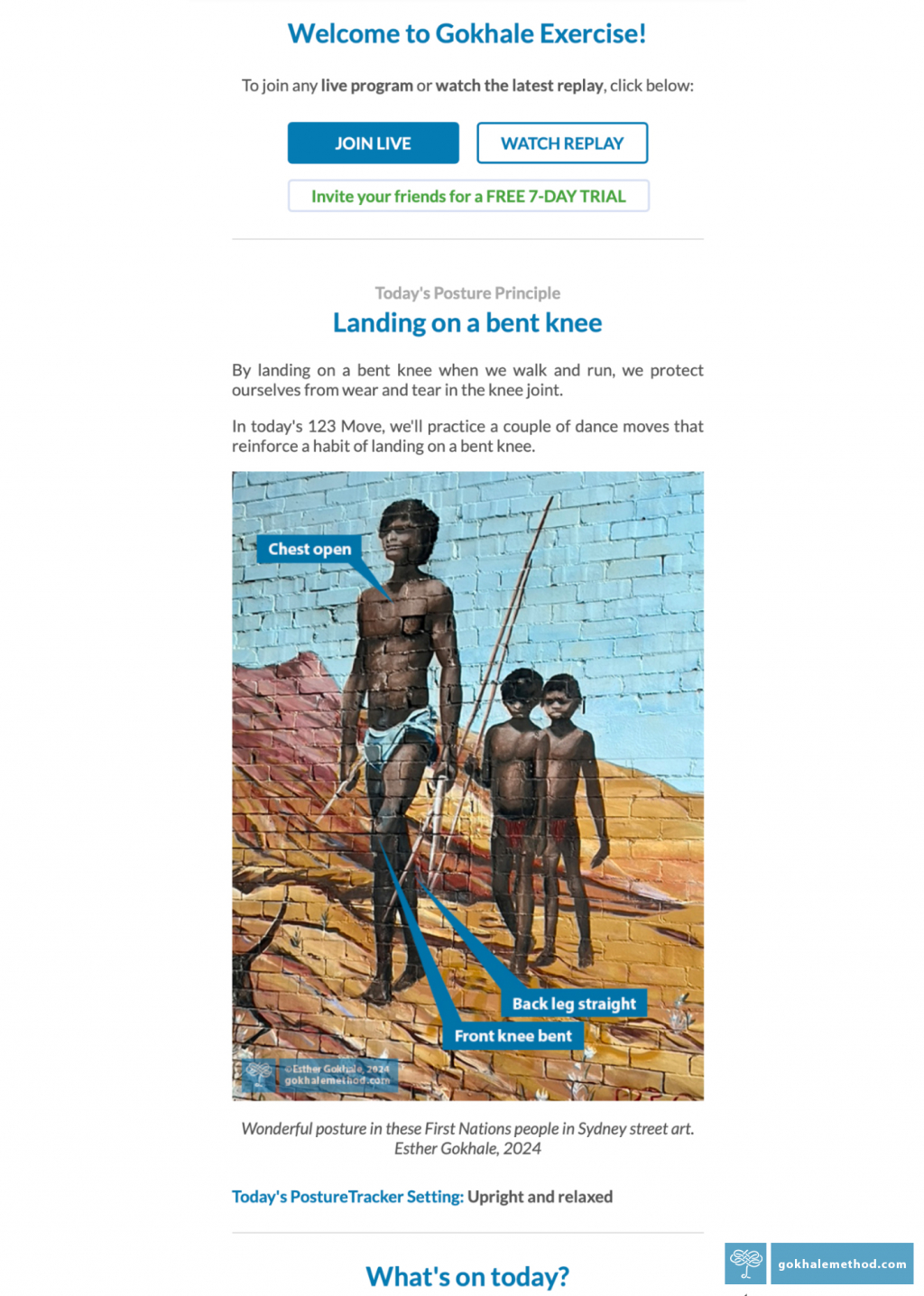
Gokhale Exercise members receive a daily email outlining the day’s program, complete with an inspirational posture reminder image. This was May 7, 2024.
In February 2023 I began experiencing pain in my hands and my left shoulder. I was diagnosed with Carpal Tunnel Syndrome (CTS) and given exercises and braces for my wrists/hands to wear at night. While the shoulder responded and had some improvement, my hands were still an issue.
At a follow-up appointment six weeks later, it was suggested I could have “a little surgery” on both hands to fix the issue. I looked up information about CTS and the surgery, and learned the pros and cons of having that done. I lived with the pain off and on until this year, when in early 2024 a diagnostic nerve test was performed by a neurologist to check the severity and cause of my particular CTS. Even though C7 (the seventh neck vertebra where nerves to the back of the arm, wrist, hand, and middle finger exit the spinal cord) was mentioned to me during the nerve assessment, the hand specialist who ordered the test did not mention it at a follow-up visit. He suggested surgery on both hands. A day after this appointment, I called the doctor’s office to find out more about possible C7 involvement and to ask if that might be the cause of my CTS. If so, how would surgery to snip the ligaments in my hands fix the problem? Since I never received a response, I did not schedule surgery.
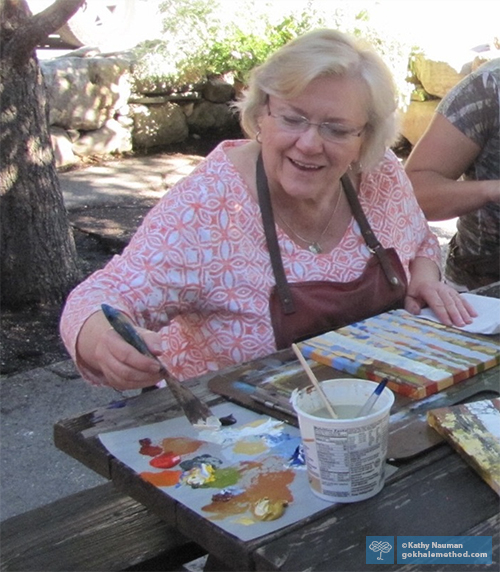
Pain-free wrists and a mobile neck are important to enjoy my hobbies. Here I am on a painting course that my daughter and I took together.
An X-ray of my cervical spine in March did indicate osteoarthritis in my neck, which in our society would be regarded as “normal” for my age. I discussed this finding with my chiropractor, who uses the Gonstead Technique. She felt confident that regular, gentle adjustments of affected areas, found by palpation and the use of a heat sensor that indicates inflammation, could be successful in eliminating the CTS symptoms. She checked my grip strength and adjusted my hands and wrists. Because I had difficulty using my hands for so long due to pain and numbness, they had become stiff and weak. I was also given suggestions about what I might do to help with my neck after my appointment. This made me once again think about what more I could do to contribute to my own healing.
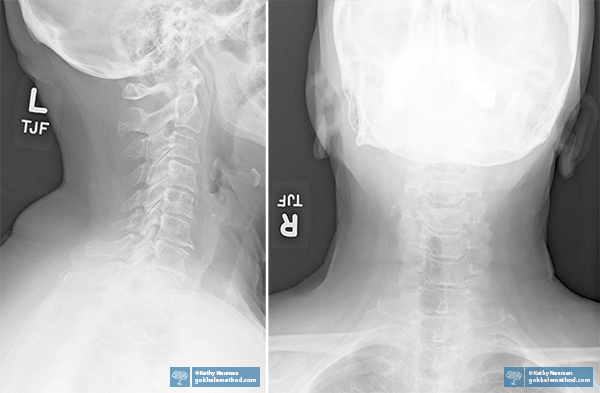
My neck X-rays showed several areas of degeneration and misalignment that would potentially cause radicular pain.
It had been almost five years since I first attended the one-day Pop Up course. I would say that up until recently, I had been somewhat “dabbling” in the Gokhale Method, without a full understanding or commitment to change my posture. Although chiropractic treatments helped to relieve my symptoms, I recognized that a healthy baseline posture was lacking, resulting in repeated misalignments. Understanding that an issue with my cervical spine might actually be the cause of my CTS, I finally came to the realization that I had been overly relying on others to fix me, and that I also needed to do everything I could to help myself. Just the thought of yet another surgery became extremely motivating!
That’s when I decided to circle back to the Gokhale Method. During an Online Follow-up with Esther in January this year, I explained that I wanted more confidence about what I should be doing for my posture and wanted coaching. Shortly after, I began the one-on-one online Elements course with Esther, which ended in April. In the early sessions, it was difficult for me to even get into positions that required me to use my hands and shoulders. By about halfway through the course, my pain from CTS had subsided, as well as the stiffness and pain in my shoulders which had not been in the healthy place they should be. I used to change up my mattresses and pillows a lot, but now I realize it’s not all about these external things—good mattresses and pillows can help, but how you position your body makes a big difference.
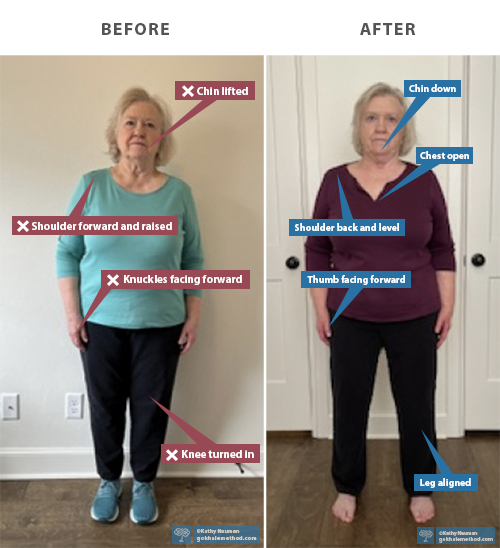
On a regular basis, non-genetic scolioses/asymmetries tend to diminish with standard Gokhale Method training—that is, without any special focus. In my case, it reduced the strain on my neck. This surprised and delighted me.
Now for the really great news! I have not experienced CTS at all since completing the Elements course. While I practice healthy posture with my whole body, as everything interrelates, my main focus has been on my neck, head, and shoulder placement. Chiropractic appointments have gone from bi-weekly, to weekly, and now, only occasionally. For weeks now, C7 has not needed an adjustment and it makes my heart so happy when my chiro tells me the instrument that measures heat and inflammation in that area is clear! She has seen how my improved posture is making a difference and has been extremely supportive of the Gokhale Method.
My exercise and walking had greatly diminished over the years after the onset of osteoarthritis, pain, and then surgeries. My upper body has been my main concern recently, but other techniques, such as glidewalking, have greatly improved my mobility and stamina. I would like to take the Advanced Glidewalking course in the future. I am working my way back to a healthy weight and an active life—thanks to the Gokhale Method.
In this video I share how glidewalking has enabled me to travel and walk longer distances in comfort.
Best next action steps
If you would like to improve your joint health, get started by booking a consultation, online or in person, with one of our teachers.
You can sign up below to join any one of our upcoming FREE Online Workshops…

Comments
Add New Comment
Login to add commment
Login